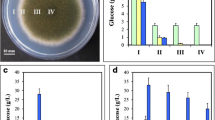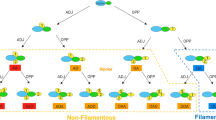Summary
0725 09
-
1.
Inhibition of the tricarboxylic acid cycle by sodium fluoroacetate (NFA) suppresses the rhythmic growth in the mutant zonata (z) of Podospora anserina and enhances its linear growth rate. However, in the wild strain, the only effect of this inhibitor is a reduction of the linear growth rate.
-
2.
The z-like growth pattern induced in the wild strain by D-galactose also is altered to uniform growth by NFA. The hyphae of the reversed colonies exhibit wild-type like shape and do not branch as intensively as the hyphae of the mutant z under normal growth conditions or of the wild strain growing on D-galactose.
-
3.
The rhythmic growth of z is also prevented, if the respiratory chain is inhibited by sodium azide. In contrast, 2,4-dinitrophenol, which uncouples oxidative phosphorylation and enhances oxidative degradation of substrates, induces rhythmic growth in the wild strain.
-
4.
Chloramphenicol and actidion (cycloheximide) do not prevent rhythmic mycelial growth, but induce this growth pattern in the wild strain.
-
5.
The results indicate that rhythmic growth in Podospora anserina results mainly from an enhancement of oxidative sugar degradation.
Similar content being viewed by others
Abbreviations
- NFA:
-
Sodium fluoroacetate
- 2,4-DNP:
-
2,4-dinitrophenol
References
Bartnicki-Garcia, S.: Cell wall chemistry, morphogenesis and taxonomy of fungi. Ann. Rev. Microbiol. 22, 87–105 (1968).
Brody, S.: Correlation between reduced nicotinamide adenine dinucleotide phosphate levels and morphological changes in Neurospora crassa. J. Bact. 101, 802–807 (1970).
Bryon, F. J.: Lysis of yeast cell walls induced by 2-deoxy-glucose at their sites of glucan synthesis. J. Bact. 95, 1169–1172 (1968).
Chevaugeon, J.: Influence de quelques substances sur la manifestation du rhythme de croissance chez l'Ascobolus immersus. C. R. Acad. Sci. (Paris) 249, 1703–1705 (1959).
— Nguyen Van, H.: Internal determinism of hyphal growth rhythms. Trans. Brit. mycol. Soc. 53, 1–14 (1969).
Crocken, B., Tatum, E. L.: The effect of sorbose on metabolism and morphology of Neurospora. Biochim. biophys. Acta (Amst.) 156, 1–8 (1968).
Durkee, T. L., Sussman, A. S., Lowry, R. J.: Genetic localization of the clock mutant and a gene modifying its band size in Neurospora. Genetics 53, 1167–1175 (1966).
Esser, K.: Genmutanten von Podospora anserina (CES). Rehm mit männlichem Verhalten. Naturwissenschaften 43, 284 (1956).
—: An introduction to Podospora anserina. Neurospora Newsletter 15, 27–31 (1969a).
—: The influence of pH on rhythmic mycelial growth in Podospora anserina. Mycologia (N.Y.) 61, 1008–1011 (1969b).
— Minuth, W.: The phenoloxidases of the ascomycete Podospora anserina. VI. Genetic regulation of the formation of laccase. Genetics 64, 441–458 (1970).
Hewitt, E. J., Nicholas, D. J. D.: Cations and anions: Inhibitions and interactions in metabolism and enzyme activity. In: Metabolic inhibitors (R. M. Hochster and J. H. Quastel, edit.). Vol. II, pp. 311–436. New York-London: Academic Press 1963.
Huang, Y. L., Ebner, K. E.: Inhibition of phosphoglucomutase by galactose-1,6-diphosphate. Experientia (Basel) 25, 917–918 (1969).
Jerebzoff, S., Lambert, E.: Chemical induction of an endogenous zonation rhythm in Aspergillus niger Van Tieghem: Specifity of the action of isoleucin. Physiol. Végét. 7, 181–189 (1969).
Johnson, B. F.: Dissolution of yeast glucan induced by 2-deoxyglucose. Exp. Cell Res. 50, 692–694 (1968).
Keppler, D., Decker, K.: Studies on the mechanism of galactosamine hepatitis: accumulation of galactosamine-1-phosphate and its inhibition of UDP-glucose pyrophosphorylase. Europ. J. Biochem. 10, 219–225 (1969).
Kuenen, R.: Crossover- und Chromatiden-Interferenz bei Podospora anserina (CES.) Rehm. Z. Vererbungsl. 93, 66–108 (1962).
Küntzel, H.: Proteins of mitochondrial and cytoplasmic ribosomes of Neurospora crassa. Nature (Lond.) 222, 142–146 (1969).
Lysek, G., Esser, K.: Rhythmic mycelial growth in Podospora anserina. I. The pleiotropic phenotype of a mutant is caused by a point mutation. Arch. Mikrobiol. 73, 224–230 (1970).
——: Rhythmic mycelial growth in Podospora anserina. II. Evidence for a correlation with carbohydrate metabolism. Arch. Mikrobiol. 75, 360–373 (1971).
Mallin, M. L., Kaplan, N. O.: Uptake of 32P in resting cells of Clostridium perfringens. J. Bact. 77, 125–130 (1959).
Marré, E., Bianchetti, R., Cocucci, S.: Rate limiting factors of glycolysis in higher plants. Ital. J. Biochem. 15, 135–144 (1966).
Neupert, W., Sebald, W., Schwab, A. J., Massinger, P., Bücher, Th.: Incorporation in vivo of 14C-labelled amino acids into proteins of mitochondrial ribosomes from Neurospora crassa sensitive to cycloheximide and insensitive to chloramphenicol. Europ. J. Biochem. 10, 589–591 (1969).
Nysterakis, F., Jerebzoff, S., Jerebzoff-Quintin, S.: Rhythmes de quelques souches de Neurospora tetrasperma Shear et Dodge. C. R. Acad. Sci. (Paris) 266, 788–791 (1968).
Oliver, I. T.: Inhibitor studies on uridine diphosphoglucose pyrophosphorylase. Biochim. biophys. Acta (Amst.) 52, 75–81 (1961).
Sargent, M. L.: Effects of four antibiotics on growth and periodicity of a rhythmic strain of Neurospora. Neurospora Newsletter 15, 17 (1969).
Schott, W. A., Tatum, E. L.: Glucose-6-phosphate dehydrogenase and Neurospora morphology. Proc. nat. Acad. Sci. (Wash.) 66, 515–522 (1970).
Sussman, A. S., Lowry, R. J., Durkee, T.: Morphology and genetics of a periodic colonial mutant of Neurospora crassa. Amer. J. Bot. 51, 243–252 (1964).
Wilson, J. F., Bates, W. K.: Effects of cycloheximide at low concentrations. Neurospora Newsletter 15, 18 (1969).
Webb, I. L.: Enzyme and metabolic inhibitors, vol. 1, p. 502. New York-London: Academic Press 1963.
West, D. J., Woodward, D. O.: Effects of respiratory inhibitors on growth of Neurospora. Neurospora Newsletter 15, 17–18 (1969).
Author information
Authors and Affiliations
Rights and permissions
About this article
Cite this article
Lysek, G. Rhythmic mycelial growth in Podospora anserina . Archiv. Mikrobiol. 78, 330–340 (1971). https://doi.org/10.1007/BF00412273
Received:
Issue Date:
DOI: https://doi.org/10.1007/BF00412273




